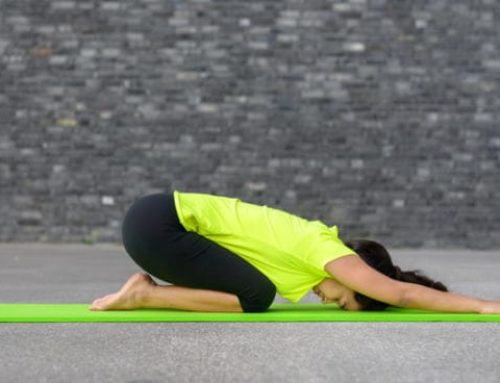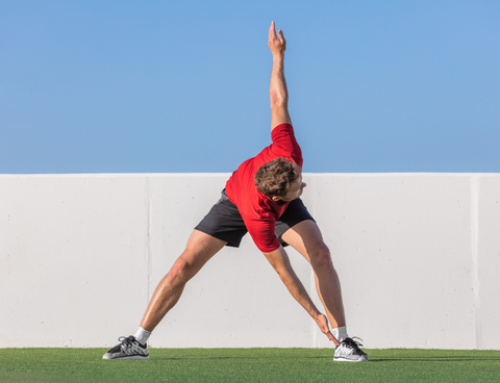6 Thoracic Spine Exercises to Improve Mobility
Most experienced coaches know one of the fastest ways to clean up a nagging shoulder, neck, or lower-back problem is to improve mid-back mobility with targeted thoracic spine exercises.
This region of the spine, from roughly the base of the neck to a few inches below the shoulder blades, has a natural outward facing curve. However, when this curve becomes excessive—due to chronic postural adaptations, faulty loading patterns or bad luck—it loses its ability to move freely.
These types of adaptations can also cause rounded shoulders, alter rib cage and abdominal mechanics, and make it difficult to raise your arms over your head without compensating movement somewhere else in the body.
We’ve all seen guys at the gym doing Military Presses with their heads craned and their lower backs in a massive arch. It’s not pretty.
Given all of this, it’s no wonder that thoracic spine mobility drills have gained so much attention by strength coaches and physical therapists over the last decade. But, like anything else, not all mobility drills are created equal.
The following strategies will increase the effectiveness of your thoracic spine mobility drills.
Add rotation to your extension drills
If you think you’ve done your due diligence by extending a few times over a foam roller during warm-ups, think again. Purely extension-based mobilizations don’t necessarily fit with what we know about the boney architecture of this region of spine.
Thoracic vertebrae have a unique shape. They’re larger in the back than in the front. This creates a natural wedge that biases the entire region toward rounding forward and acts as a boney block to standing up straight.
In addition, the intervertebral discs between the thoracic vertebrae happen to be the Danny DeVitos of spinal hardware—shorter, fatter and less mobile than the discs in the neck and lower back—which gives them a lot of stability but limited mobility.
It’s no wonder that performing face-up extensions over a foam roller doesn’t do much for most people.
I prefer to combine extension-rotation drills to work the thoracic spine’s large rotational capacity.
Two of my favorite drills are the Upper Body Windmill and the Quadruped Extension-Rotation.
Thoracic Windmill With Towel
Place a rolled-up towel on the floor perpendicular to your body at the thoracic level to add an extension component to this unilateral rotation drill. Perform 8-10 reps on each side.
Quadriped Thoracic Rotation
Mobilize from the inside out
If stretching and foam rolling are permanent settlements in the land of do-it-yourself thoracic mobility, then breathing is the next frontier.
From a mobility standpoint, it’s virtually impossible to overstate the influence of breathing on thoracic spine position. The coordinated action of the diaphragm, abdominals and accessory respiratory muscles interacting with the rib cage produces upwards of 21,000 breaths a day for the average person.
I’m vastly oversimplifying here, but unevenness in the body’s structure and motion can inhibit your diaphragm. When this happens, the muscles of the upper rib cage increase their resting tone. The change in rib position causes the shoulders to round and the upper ribs to rotate forward, limiting thoracic extension.
Luckily, this doesn’t need to be a terminal diagnosis. Adding a few positional breathing techniques can go a long way toward normalizing thoracic rib position and improving mobility.
Below are a few drills I picked up from the Postural Restoration Institute.
Short-Seated Wall Reach
Sit on the floor with your back and hips against a wall. Breathe in fully through your nose before forcefully exhaling through your mouth and reaching forward with your arms. Your lower back should stay on the wall throughout.
Concentrate on filling the back of your chest wall with air while breathing in and reaching your shoulder blades as far around the front of your ribs as possible on the way out.
Repeat for 2-3 sets of 3-4 breaths. Pause for three seconds at the end of each breath.
Overhead Breathing Squat
This exercise builds off the last one, adding both a standing component and taking the arms into an overhead position. I like stretch bands best for this exercise, but you can always use the overhead cable from a lat pull-down machine.
Cement new ranges of motion with stability and strength
Most people intuitively appreciate the link between static stretching or foam rolling and improved mobility, so we shouldn’t overlook the role that strength and stability training plays in maintaining these gains.
If temporary gains in mobility are to have a fighting chance of lasting beyond a single training session, the nervous system has to recognize and assimilate them into a new movement pattern.
Try pairing one of the thoracic mobility drills above with one of these strength exercises.
Band-Resisted Thoracic Rotations
This drill draws the horizontal abductors and external rotators of the shoulder into the equation, fusing thoracic mobility with usable shoulder range of motion. Just make sure to keep your hips and lower back out of the equation, as they can easily shift the rotation to where it’s not wanted.
Modified Reverse Dumbbell Fly
Like the previous drill, the Modified Fly incorporates shoulder function into the mix, but this time with a bit more explosiveness to mimic the demands of real-world rotational force.
Read more:
RECOMMENDED FOR YOU
MOST POPULAR
6 Thoracic Spine Exercises to Improve Mobility
Most experienced coaches know one of the fastest ways to clean up a nagging shoulder, neck, or lower-back problem is to improve mid-back mobility with targeted thoracic spine exercises.
This region of the spine, from roughly the base of the neck to a few inches below the shoulder blades, has a natural outward facing curve. However, when this curve becomes excessive—due to chronic postural adaptations, faulty loading patterns or bad luck—it loses its ability to move freely.
These types of adaptations can also cause rounded shoulders, alter rib cage and abdominal mechanics, and make it difficult to raise your arms over your head without compensating movement somewhere else in the body.
We’ve all seen guys at the gym doing Military Presses with their heads craned and their lower backs in a massive arch. It’s not pretty.
Given all of this, it’s no wonder that thoracic spine mobility drills have gained so much attention by strength coaches and physical therapists over the last decade. But, like anything else, not all mobility drills are created equal.
The following strategies will increase the effectiveness of your thoracic spine mobility drills.
Add rotation to your extension drills
If you think you’ve done your due diligence by extending a few times over a foam roller during warm-ups, think again. Purely extension-based mobilizations don’t necessarily fit with what we know about the boney architecture of this region of spine.
Thoracic vertebrae have a unique shape. They’re larger in the back than in the front. This creates a natural wedge that biases the entire region toward rounding forward and acts as a boney block to standing up straight.
In addition, the intervertebral discs between the thoracic vertebrae happen to be the Danny DeVitos of spinal hardware—shorter, fatter and less mobile than the discs in the neck and lower back—which gives them a lot of stability but limited mobility.
It’s no wonder that performing face-up extensions over a foam roller doesn’t do much for most people.
I prefer to combine extension-rotation drills to work the thoracic spine’s large rotational capacity.
Two of my favorite drills are the Upper Body Windmill and the Quadruped Extension-Rotation.
Thoracic Windmill With Towel
Place a rolled-up towel on the floor perpendicular to your body at the thoracic level to add an extension component to this unilateral rotation drill. Perform 8-10 reps on each side.
Quadriped Thoracic Rotation
Mobilize from the inside out
If stretching and foam rolling are permanent settlements in the land of do-it-yourself thoracic mobility, then breathing is the next frontier.
From a mobility standpoint, it’s virtually impossible to overstate the influence of breathing on thoracic spine position. The coordinated action of the diaphragm, abdominals and accessory respiratory muscles interacting with the rib cage produces upwards of 21,000 breaths a day for the average person.
I’m vastly oversimplifying here, but unevenness in the body’s structure and motion can inhibit your diaphragm. When this happens, the muscles of the upper rib cage increase their resting tone. The change in rib position causes the shoulders to round and the upper ribs to rotate forward, limiting thoracic extension.
Luckily, this doesn’t need to be a terminal diagnosis. Adding a few positional breathing techniques can go a long way toward normalizing thoracic rib position and improving mobility.
Below are a few drills I picked up from the Postural Restoration Institute.
Short-Seated Wall Reach
Sit on the floor with your back and hips against a wall. Breathe in fully through your nose before forcefully exhaling through your mouth and reaching forward with your arms. Your lower back should stay on the wall throughout.
Concentrate on filling the back of your chest wall with air while breathing in and reaching your shoulder blades as far around the front of your ribs as possible on the way out.
Repeat for 2-3 sets of 3-4 breaths. Pause for three seconds at the end of each breath.
Overhead Breathing Squat
This exercise builds off the last one, adding both a standing component and taking the arms into an overhead position. I like stretch bands best for this exercise, but you can always use the overhead cable from a lat pull-down machine.
Cement new ranges of motion with stability and strength
Most people intuitively appreciate the link between static stretching or foam rolling and improved mobility, so we shouldn’t overlook the role that strength and stability training plays in maintaining these gains.
If temporary gains in mobility are to have a fighting chance of lasting beyond a single training session, the nervous system has to recognize and assimilate them into a new movement pattern.
Try pairing one of the thoracic mobility drills above with one of these strength exercises.
Band-Resisted Thoracic Rotations
This drill draws the horizontal abductors and external rotators of the shoulder into the equation, fusing thoracic mobility with usable shoulder range of motion. Just make sure to keep your hips and lower back out of the equation, as they can easily shift the rotation to where it’s not wanted.
Modified Reverse Dumbbell Fly
Like the previous drill, the Modified Fly incorporates shoulder function into the mix, but this time with a bit more explosiveness to mimic the demands of real-world rotational force.
Read more:










